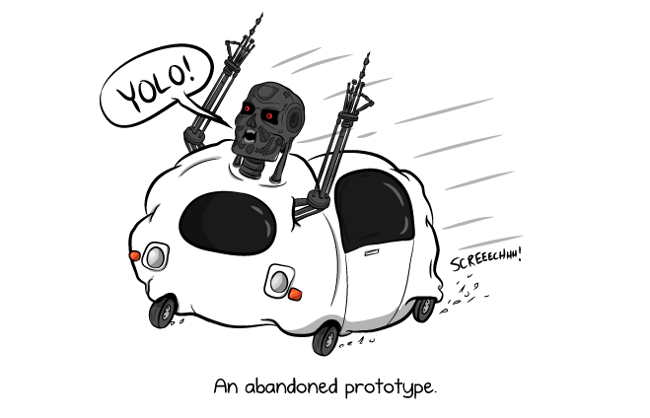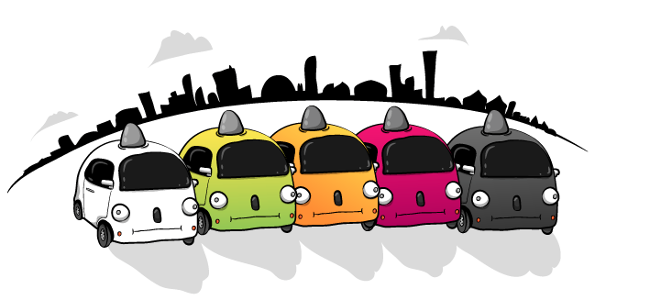The same week search giant Google confirmed it completed the first real build of its self-driving vehicle, The Oatmeal’s cartoonist Matthew Inman said he believes the technology can’t come to our streets fast enough.
Inman got to take a test ride in the new autonomous vehicle and said his first impression of the vehicle was that it was more cautious than dangerous.
“It drove slowly and deliberately, and I got the impression that it’s more likely to annoy other drivers than to harm them,” Inman said.
“Google can adjust the level of aggression in the software, and the self-driving prototypes currently tooling around Mountain View (in California) are throttled to act like nervous student drivers.”
Google confirmed this week that the first prototype of its new self-driving car has been completed.
“The vehicle we unveiled in May was an early mockup – it didn’t even have real headlights,” Google said on its Google+ page for the Self-Driving Car Project.
“Since then, we’ve been working on different prototypes of prototypes, each designed to test different systems of a self-driving car – for example, the typical ‘car’ parts like steering and braking, as well as the ‘self-driving’ parts like the computer and sensors. We’ve now put all those systems together in this fully functional vehicle – our first complete prototype for fully autonomous driving.
“We’re going to be spending the holidays zipping around our test track, and we hope to see you on the streets of Northern California in the new year. Our safety drivers will continue to oversee the vehicle for a while longer, using temporary manual controls as needed while we continue to test and learn.”
The cars have the ‘cute’ factor’

Image via The Oatmeal
Pictures of the machine show something reminiscent of something Mr Bean would drive, and would surely horrify the aesthetic principles of Silicon Valley neighbours, such as Jony Ive, consumer tech titan Apple’s senior vice-president of design. Let’s just say that even Top Gear’s Jeremy Clarkson will more than likely recoil in horror.
However, Inman instinctively thinks otherwise, labeling the new self-driving cars as “cute”.
He said: “Google’s new fleet was intentionally designed to look adorable. Our brains are hardwired to treat inanimate (or animate) objects with greater care, caution, and reverence when they resemble a living thing. Psychological studies have been done whereby participants, when asked to harm an inanimate object, were less likely to hurt the object if it had a face. Participants in the study would happily bludgeon a potato with a hammer, unless you stuck some hair and a pair of eyeballs to the potato, at which point their moral compasses would obediently snap into place.
“By turning self-driving cars into an adorable Skynet Marshmallow Bumper Bots, Google hopes to spiritually disarm other drivers. I also suspect the cuteness is used to quell some of the road rage that might emerge from being stuck behind one of these things. They’re intended as moderate-distance couriers, not open-road warriors, so their max speed is 25 miles per hour.”
Inman also grasped the innate intelligence in the machine. It didn’t turn right at an exit because a pedestrian was close to the edge of the path. Once it was certain the pedestrian wasn’t likely to cross the street, the car pulled out.
‘I’m ready for our army of Skynet Marshmallow Bumper Bots’

Image via The Oatmeal
Inman is clearly a convert to the self-driving car genre. He pointed out his mother had a stroke, which limited her mobility, but also that 45pc of disabled people in the US actually work. Also, he noted that 95pc of a car’s lifetime is spent parked.
People, he said, need to grasp the opportunity. “They ignore how this technology could transform the lives of the elderly, or eradicate the need for parking lots or garages or gas stations. They dismiss the entire concept because they don’t think a computer could ever be as good at merging on the freeway as they are.
“They ignore the great, big, beautiful picture staring them right in the face: that this technology could make our lives so much better.”
His conclusion is that the technology is proving to be superior than human drivers and that already each self-driving car in Google’s fleet learns from other vehicles and each now possesses 40 years of driving experience.
“And this technology is still in its infancy. I say ignore the anecdotes, embrace the data.
“I’m ready for our army of Skynet Marshmallow Bumper Bots.
“I’m ready for the future. I’m ready for the marshmallows.”